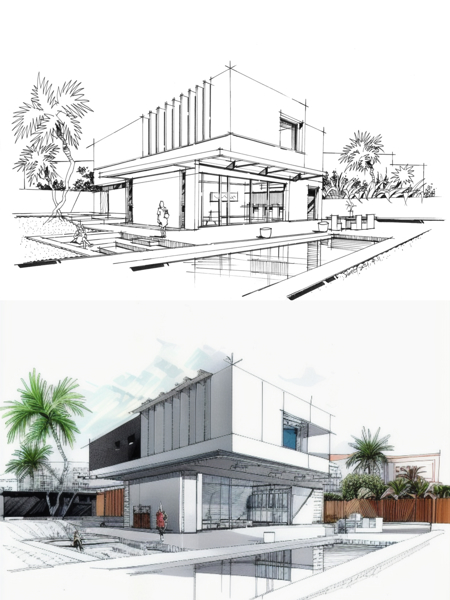Changing Spaces: The Vision of CDA Architects for Modern Living
Changing Spaces: The Vision of CDA Architects for Modern Living
Blog Article
Understanding the Collaborative Process In Between Engineers and Engineers in Modern Building Projects
The collective process in between engineers and engineers is important in contemporary building and construction projects, as it integrates layout intent with design usefulness. Checking out these characteristics exposes understandings that could dramatically influence job results and total industry standards.
The Relevance of Partnership
The collaborative harmony in between architects and engineers is crucial for the effective understanding of any kind of building job. This partnership combines distinct know-how and perspectives, allowing the assimilation of ingenious design with sensible engineering services. By working together, designers and engineers can make certain that a job not only meets visual and useful needs yet additionally sticks to safety and security, sustainability, and financial constraints.
Cooperation cultivates a common vision, assisting in the placement of goals and expectations from the beginning. This alignment is critical in addressing possible difficulties and mitigating dangers that can occur during the task lifecycle. In addition, a joint strategy allows for the effective appropriation of sources, optimizing both time and cost.
The significance of partnership encompasses the repetitive procedure of style and building and construction, where responses from designers can inform architectural decisions, resulting in more possible and sustainable designs. Alternatively, designers can inspire designers to believe creatively concerning exactly how to accomplish architectural stability without compromising imaginative intent. Inevitably, the collaborative relationship between designers and designers is not just helpful; it is essential to the production of high-quality, useful, and innovative developed atmospheres that meet the needs of culture.
Communication Methods and Devices
Reliable communication techniques and tools are important for cultivating collaboration in between architects and designers throughout the job lifecycle. Establishing clear channels of interaction is essential to guarantee that all staff member are aligned with task objectives, timelines, and duties. Routine meetings, both in-person and online, provide chances for stakeholders to review development, address problems, and make informed decisions.

Furthermore, embracing collective interaction tools, such as Slack or Microsoft Teams, enables instant messaging, documents sharing, and recurring discussions, advertising a much more agile action to emerging problems. File monitoring systems likewise play an essential role in arranging task paperwork, guaranteeing that all group members have accessibility to the most up to date info.
Shared Goals and Project Vision
A combined task vision serves as the foundation for effective cooperation in between engineers and engineers (cda architects). This common vision not just lines up the efforts of here both parties but additionally establishes an usual framework for decision-making throughout the project's lifecycle. By verbalizing clear objectives, stakeholders can successfully browse the intricacies of modern construction projects, making certain that both aesthetic and functional needs are met
Establishing shared objectives entails open discussion and a thorough understanding of each technique's contributions. Designers usually focus on design intent, spatial partnerships, and customer experience, while engineers stress architectural integrity, systems functionality, and compliance with laws. When these viewpoints are aligned, the outcome is a cohesive job that abides by both imaginative goals and technological expediency.
Furthermore, a distinct project vision fosters liability amongst group participants, encouraging each participant to take ownership of their function in achieving the preferred outcome. Normal check-ins and collective workshops can better imp source reinforce this dedication, enabling adjustments to be made as the task evolves. Inevitably, a shared vision not just boosts synergy yet also raises the quality of the last deliverable, causing effective project completion.
The Duty of Modern Technology
Leveraging innovation has ended up being important in boosting cooperation in between engineers and engineers. Structure Details Modeling (BIM) stands out as a crucial innovation, permitting both architects and designers to develop detailed 3D versions that envelop layout intent and architectural integrity.
In addition, cloud-based platforms enable seamless cooperation, permitting project stakeholders to gain access to and upgrade task information from anywhere. This promotes a society of transparency and accountability, as adjustments can be tracked and examined in real-time. Additionally, mobile applications additional enhance communication, giving on-site groups with instant access to job specifications and updates.
Arising technologies such as fabricated intelligence and machine understanding are additionally beginning to play a function in anticipating evaluation, assisting teams recognize prospective problems before they occur. Inevitably, the duty of innovation in architecture-engineering cooperation not only boosts workflow efficiencies however likewise boosts technology, causing even more successful project end results. By accepting these technical developments, designers and designers Go Here can make certain a much more natural and productive joint procedure throughout the building and construction lifecycle.
Study in Successful Collaborations
Many study illustrate the profound influence of reliable collaborations between engineers and designers on job results. One significant instance is the collaboration on the High Line in New York City, where landscape designers, engineers, and city coordinators interacted to transform an abandoned railway right into a lively public park. This multidisciplinary strategy not only improved the aesthetic quality but also guaranteed structural safety and ecological sustainability.

The Burj Khalifa in Dubai even more demonstrates the value of collective efforts - cda architects. The assimilation of style and design knowledge enabled the project group to accomplish unmatched heights while adhering to safety and security policies and aesthetic vision
These examples highlight the significance of communication, depend on, and shared goals. In today's complicated building atmosphere, such collaborations are important to browsing obstacles and providing tasks that meet both practical and visionary goals.
Conclusion
In conclusion, the cooperation in between engineers and designers is essential for the success of contemporary building and construction tasks. Efficient interaction techniques, a shared task vision, and the assimilation of advanced innovations are critical components that facilitate this collaboration.
Report this page